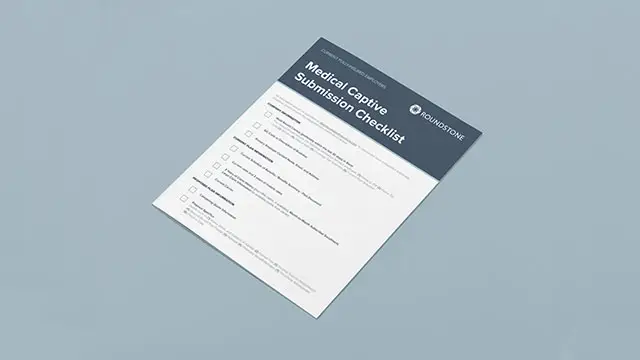Highlights
- Level-funded insurance and self-funded insurance are alternatives to traditional fully insured plans.
- Unlike self-funded plans, level-funded health insurance offers little control over plan elements like TPAs, PBMs, or network providers.
- Self-funded group captive insurance from Roundstone provides you with full control over your insurance plan.
- Roundstone’s group captive plan guarantees employers keep 100% of their unused claims dollars at the end of the coverage period.
- A self-funded group captive plan has a greater positive impact on your bottom line and employee health than level-funded insurance.
Health insurance costs are on the rise. Typical health insurance for small and mid-size businesses costs approximately $7,739 per employee and $22,221 per family annually. This significant increase in pricing is causing many employers to search for affordable insurance options to lower health insurance expenses without sacrificing the quality of care for their employees.
Popular alternatives are level-funded programs and self-funded group captive plans. Learn the differences between level-funded versus self-funded insurance and why self-funded group captive insurance with Roundstone offers you more control over health insurance costs.
Basics of Level-Funded Insurance
Level-funded insurance refers to a health insurance plan in which an employer pays a set premium amount each month to an insurance carrier or Third-Party Administrator (TPA). The insurance company or TPA puts these funds into an account to cover claims, stop-loss coverage premiums, and administrative expenses.
Your monthly premium in a level-funded plan is based on an estimated maximum cost or worst-case claims projection. This projection includes the cost of a stop-loss policy, which limits the financial risk for catastrophic claims. The benefit of this type of health insurance is that if your claims are lower than expected, there is the possibility of receiving a refund at the end of the plan year.
Characteristics of Level-Funded Insurance
Nearly 16% of firms with 3 to 99 employees use level-funded plans for health insurance. The popularity of level-funded plans is due to the hybrid nature of the arrangement, which mimics the fully insured funding experience while offering the potential for a refund on underused claim funds. Despite the plan’s seemingly beneficial nature, it offers no control over plan design, plan document, cost-containment, TPA, Pharmacy Benefit Managers (PBMs), or network.
Limited plan design
You may or may not be offered plan design options to choose from with level-funded insurance. Typically, the choice is between two plans, neither of which offer you control over the network, TPA, PBM, or cost-containment strategies. Essentially, you are stuck choosing between two plans that are pre-formatted by the insurance carrier, much like with a fully insured plan.
Strings-attached refund
Although level-funded insurance offers the possibility of a refund at the end of the coverage period, you aren’t likely to see those funds in full (or even in cash). Your insurance carrier keeps a large portion of those unused funds.
On average, level-funded plans refund less than 50% of the excess claims funds back to you at the end of the year. If you receive a refund, you will likely receive a credit to pay part of next year’s costs, rather than a check you can deposit in the bank and use for your business.
Additionally, you may be forced to renew your benefits with the carrier to receive a refund.
“When you choose a level-funded plan and want to switch carriers at renewal, you won’t see your refund, even if you didn’t spend all your claims money.”
Rate increases
Just like fully insured plans, you can expect to see steep rate increases if you go over your claims spending. Level-funded plans do not typically offer thorough transparency on claims data, so there is often no way to track your spending throughout the year or to contain costs. This traps you in a cycle of overspending and surprise yearly rate increases.

Basics of Self-Funded Insurance
Self-funded insurance refers to a health insurance plan that an employer funds. This is a popular choice among large companies. With a self-funded plan, you put money into a reserve account for claims and purchase stop-loss insurance to cover claims that exceed your agreed-upon per claim and maximum costs.
In self-funding, you retain complete control over every aspect of your plan, from plan design to the TPA, PBM, network, and cost-containment strategies you use.
Self-Funded Group Captives
One option for employers who wish to self-fund is to join a group captive plan. A group captive plan is self-funded by a group of like-sized companies who pool their funds to minimize risk. This is a risk-averse way to fund health insurance like a Fortune 500, by sharing the risk with the other members of the captive.
In a group captive plan from Roundstone, each member combines their premiums with other captive participants to obtain affordable, high-level coverage with a lot of flexibility.
Instead of adhering to a fixed monthly premium that benefits the insurance company, you pay claims as they occur. Your premiums are determined through standard insurance methodology using risk assessments and demographic information.
However, with a group captive plan, your fixed costs are only 15% of your total expenses, leaving you with 85% variable expenses that can be reduced with plan design and cost-containment solutions.
Benefits of a Self-Funded Plan
The benefits of using a self-funded group captive plan mitigate any concerns of switching from a level-funded or fully insured plan. Self-funded group captive perks include risk transfer, full refund on unused claims funds, and freedom of choice in plan design.
Risk sharing. With a self-funded plan, you share risk with the other members of the group captive. This reduces year over year cost volatility and protects you from outsized premium renewals based on catastrophic or high-cost claims you may incur.
As part of a group captive, you purchase a stop-loss policy covering your claims over retained deductible levels. Stop-loss policies apply to large aggregate employee claims (frequency) as well as individual high-expense claims (severity).
Freedom of choice. Self-funded plans offer you complete freedom of choice when it comes to TPAs, network, plan documents, plan design, and cost-containment solutions. From the beginning, you choose your own Summary Plan Description (SPD) and your own TPA to process administrative tasks such as claim adjudication.
This allows you to find a TPA who specializes in what matters most to your company’s specific population. You can also choose your network, which offers your employees the best possible care for their needs.
Data transparency. Self-funded plans are focused on providing claims data transparency. Seeing your claims data gives you the power to analyze the numbers to see where you need extra coverage and where you can implement cost-containment solutions to optimize utilization and lower costs.
With features like Roundstone’s CSI Dashboard and CSI Team, you have access to your claims data that is easy to understand and provides action-based insights about your costs. With your claims information, you can implement special programs, switch networks, or implement any one of our 150+ cost-containment strategies to lower costs.
Keep what you don’t spend. With group captive insurance, you keep 100% of your claims funds that are not used throughout the year. You keep all of your savings instead of donating them to the pockets of your insurance carrier.
Based on how well you implement cost-containment strategies throughout the year, Roundstone will refund any unspent premium pro rata. The most recent distribution was 17% of total stop-loss premiums.
These savings continue year after year, yielding better results as your business (and your plan) evolve. These additional savings are returned to employers in the form of an annual cash distribution check, not a credit.
Similarities Between Level-Funding and Self-Funding
There are a few similarities between level-funded and self-funded health insurance plans, including:
-A departure from a fully insured model
-A pharmacy plan and network access for the insured
-Custom plan pricing
-A plan description
-A stop-loss premium
How Level-Funded and Self-Funded Differ
Despite superficial similarities, self-funded and level-funded insurance plans provide very different coverage options and benefits to employees. Consider the following differences between level-funded vs. self-funded insurance plans.
Refunds
Level-funded refunds are typically issued by credit only and require staying with the current insurance carrier. These “refunds” only average about 40% of your actual savings.
You keep 100% of your unused claims dollars with self-funded insurance, and the refund is in the form of cash. This model encourages you to actively design your insurance plan and gives you control over your health insurance choices.
If you do decide to change carriers, you still keep your unused claims funding from the prior year. Roundstone employers also get an annual distribution check of the captive’s leftover pooled stop-loss premium money on a pro rata basis.
Data transparency
Level-funded insurance plans don’t favor claims data transparency. They keep you in the dark about how your money is spent, preventing you from making cost-effective changes.
A self-funded group captive with Roundstone offers you access to the CSI Dashboard tool, which helps analyze your costs. We also put you in contact with our CSI Team, a group of professionals designated to offer you specific cost-containment solutions.
Control
You have no freedom to choose different or unique plan designs with a level-funded plan. You may have the option between two plans, but the insurance company decides on every other aspect of the plan for you.
With a group captive insurance plan, you build your own customized health insurance plan that fits your needs and budget. You opt for your own vendors, network providers, TPAs, and PBMs that give you the best care for your demographics at the best price.
Fixed costs
A level-funded plan is carrier-based insurance. You pay a fixed premium with no room to change aspects such as TPAs or PBMs to adjust your price.
Self-funded insurance limits fixed costs to 15% of the total cost of the plan. With 85% of your insurance expense in the “variable spend” category, you can change the plan details to suit your healthcare and budgetary needs. This gives you more freedom to choose the plan design options that work best for your employees and save money while doing it.
Impact of Level-Funded and Self-Funded Plans
Level-funded and self-funded plans have different impacts on your company’s bottom line and level of employee healthcare benefits. Given the major variations in each type of non-traditional insurance plan, it is important to consider the impact of self-funded and level-funded plans on your small to mid-sized business.
Impact of Level-Funded Plans
Level-funded plans are set up to resemble fully insured plans. They require a fixed monthly premium, allow no alterations to plan design, and provide no data transparency for decision-making.
The potential draw of an end-of-year refund for unused premiums, the only non-fully insured potential benefit, doesn’t always pan out with level-funded insurance.
With level-funded insurance, you get less stability and security than traditional insurance and less flexibility and cost-savings potential than self-funded plans.
Level-funded insurance tends to have a neutral or negative impact on your health insurance costs, as you cannot change or adjust costs during the year. With no data transparency, you aren’t allowed to see where your premiums are going, which keeps you frustrated and in the dark, just like on a traditional insurance plan.
With little to no change in networks, TPAs, PBMs, or wellness and health management programs, you are unlikely to see a beneficial impact on employee health or performance. When you use a level-funded insurance plan, your bottom line and employee health benefits are impacted adversely or not at all.
Impact of Self-Funded Plans
The impact of self-funded group captive insurance is beneficial to both employees and your company’s bottom line. Self-funding allows you to access your claims data and gain actionable insights into how to lower your expenses.
By enacting cost-containment strategies gleaned from this information, you save money in areas such as pharmacy spending, urgent care utilization, and ER visits.
When you lower your claims costs, you increase the funds returned to you at the end of the year. This year-over-year return on premiums reduces cost volatility and allows you to put the money back into the plan. These returns come in the form of employee wellness programs, cost share reductions for employees, or other beneficial health management programs.
When you reduce costs, enact wellness programs and provide your employees with access to higher-quality care, you make a difference in your employees’ quality of life. You’ll likely see a positive impact on morale, physical health, and mental health among your staff as well.
A self-funded group captive plan helps you care for the people who look to you for health insurance and reduces overall spending for your company.

Explore the Benefits of Self-Funded Insurance With Roundstone
Group captive insurance gives small to midsize businesses access to the same health insurance model that Fortune 500 companies have used for decades. With a self-funded group captive plan, you can lower your healthcare expenses every year and provide your team with exceptional coverage that meets their needs.
Find out how you can save thousands every year with a group captive plan from Roundstone. Contact us today at 440-617-0333 or fill out our contact form online.











